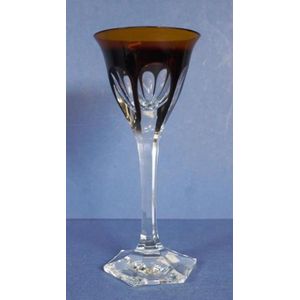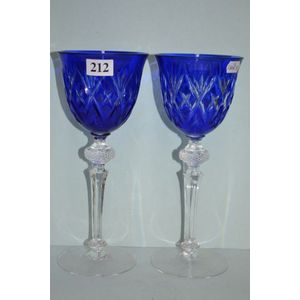Stuart Devlin Dessert Cup with Gilt Floriform Mount
A Stuart Devlin sterling silver and gilt dessert cup, early 1970s London, with maker's mark SD, numbered 4 from a series of 25, sets, partial date letter, with original box and associated papers dated 1973, the martini style cup with a cast chiselled floriform mount and stem, hallmarked to bowl, numbered underside, total weight 259gr, height 11 cm
You must be a subscriber, and be logged in to view price and dealer details.
Subscribe Now to view actual auction price for this item
When you subscribe, you have the option of setting the currency in which to display prices to $Au, $US, $NZ or Stg.
This item has been sold, and the description, image and price are for reference purposes only.
- Devlin Stuart - Stuart Devlin was born in Geelong, Victoria, Australia and trained as an art teacher, after which he taught for 5 years and then studied gold and silversmithing, firstly in Melbourne and then at the Royal College of Art in London from 1958. He spent two years at Columbia University where he developed a career as a sculptor.
He returned to his teaching position in Melbourne in 1962 and was appointed Inspector of Art Schools.
In 1963 a competition was held to design the new Australian decimal coinage that was to be introduced in 1966. The new decimal coins were to replace the pre decimal coinage that had been in circulation since 1910. Six competitors vied for the honour of designing these new coins.
Devlin was announced the winner of the competition with designs that featured Australian native fauna on the new coins, with the 1c coin featuring the feather-tailed glider, the 2c a frilled neck dragon lizard, 5c a spiny echidna, the 10c a lyrebird, the 20c duck billed platypus and the 50c Australian Coat of Arms. The 1,c and 2c coins are no longer in circulation. A $1 coin also designed by Devlin and featuring the kangaroo, was introduced in 1984
In 1963 He became involved in the project to design Australia's decimal currency, and during this period he decided to relocate to London and establish himself as a silversmith.
He adapted his knowledge of sculpture into the designs he created for his showroom in Conduit Street in London's West End, which he occupied from 1979 to 1985. His output included limited editions which appealed to longer term collectors, such as Easter eggs and Christmas boxes.
His design skills have extended to furniture, jewellery, clocks, centrepieces, goblets, candelabra, bowls, and insignia.
Following his successful design on Australia's decimal currency, he has designed coins and medals for 36 countries.
He was Prime Warden of the Goldsmith's Company 1996-97 and in 1982 was appointed as goldsmith and jeweller to Queen Elizabeth II and in 1998 he was appointed a member of the Royal Mint Advisory Committee on the Designs of Coins, Medals, Seals and Decorations.
In 2000 he designed 25 coins for the Sydney Olympic Games including the Silver Kilo Olympic Masterpiece, the largest Olympic coin ever made, and the first to show all Olympic sports. He was also awarded an honorary doctorate from RMIT in 2000.
His work is displayed in the Victoria and Albert Museum as well as numerous Australian museums including Powerhouse Museum, Sydney, Museum Victoria and the National Gallery of Victoria.
He was awarded a Companion of the Order of St Michael and St George in the UK in 1980, and an Order of Australia in 1988. - Hallmarks - A mark stamped on articles of precious metals in Britain, since the 14th century, certifying their purity. It derives its name from the Guild Hall of the Goldsmiths' Company, who recieved its Charter in 1327 giving it the power to assay (test the purity) and mark articles of gold and silver.
The hallmark will consist of several marks, including the:
- silver standard mark, indicating the purity of the metal. Sterling silver is .925 pure silver.
- the city mark indicating the city in which it was assayed eg London, Birmingham, York etc.
- the date mark, usually a letter of the alphabet in a particular font and case,
- a duty mark, indicating whether duty had been paid to the crown, and only in use from 1784 to 1890
The piece may include an additional mark, the maker's mark, although not forming part of the hallmark, will be located in the vicinity of the hallmarks.
Sometimes silver plated items will bear faux hallmarks, often confusing those not familiar with silver markings. - Date Letter on Silver - A date letter is a letter or symbol that is used to mark silver and other precious metals to indicate the year in which the piece was made. The date letter system is used by the British hallmarking system and it is a way to verify that a piece of silver is genuine and has been assayed (tested) by an official assay office.
The date letter system has been in use since the 14th century and it changes every year, so it is possible to identify the year in which a piece of silver was made by looking at the date letter. The date letter is usually stamped alongside other hallmarks such as the maker's mark, and the standard mark (indicating the fineness of the metal) on the silver piece. The style of the letters varies depending on the assay office, and the style of the lettering also changes over time. The date letter is usually placed inside a shield shape, sometimes accompanied by other symbols.
The date letter system is not used in all countries, so if a piece of silver does not have a date letter, it does not necessarily mean it is not authentic. The date letter system is not always used for small or insignificant silver items. - Sterling Silver - Sterling silver is a mixture of 92.5% pure silver and 7.5% of another metal, usually copper. Fine silver is 99.9% pure silver, and is relatively soft and the addition of the very small amount of copper gives the metal enough strength and hardness to be worked into jewellery, decorative and household objects.
This item has been included into following indexes:
Visually similar items

Good Moser crystal goblet, with bronze and clear tones, signed to base, height 19.5 cm
Sold by
in
for
You can display prices in $Au, $US, $NZ or Stg.

A Kosta Boda Bertil Vallien Martini glass. Height 17 cm. Split from four various art glass items (4)
Sold by
in
for
You can display prices in $Au, $US, $NZ or Stg.

A Georgian opaque twist wine glass with tapered conical bowl, English, 18th century. 20 cm high
Sold by
in
for
You can display prices in $Au, $US, $NZ or Stg.

Pair of WMF bristol blue cut crystal stem wine glasses
Sold by
in
for
You can display prices in $Au, $US, $NZ or Stg.
